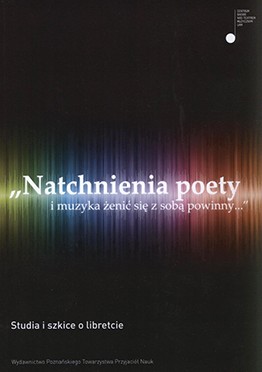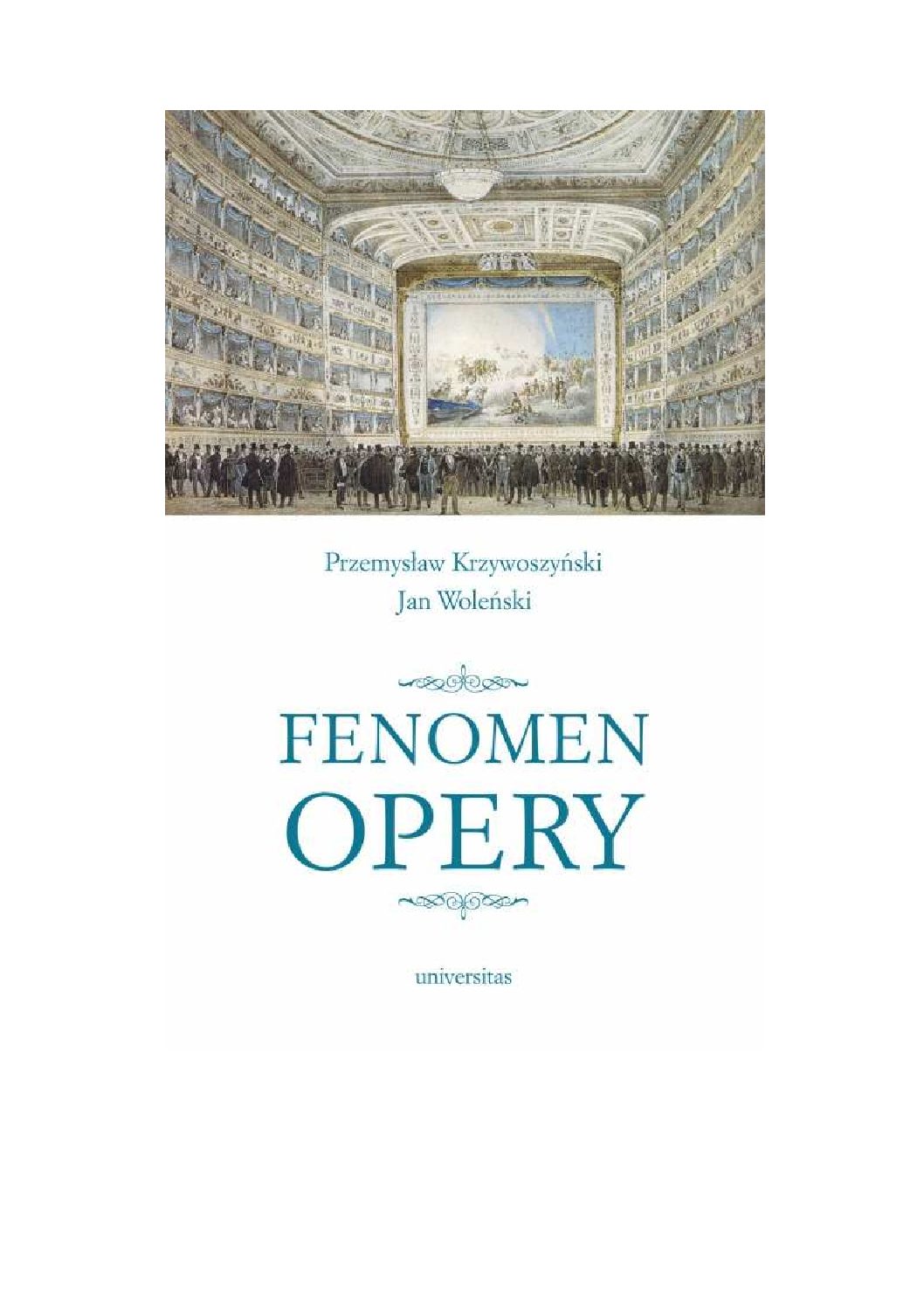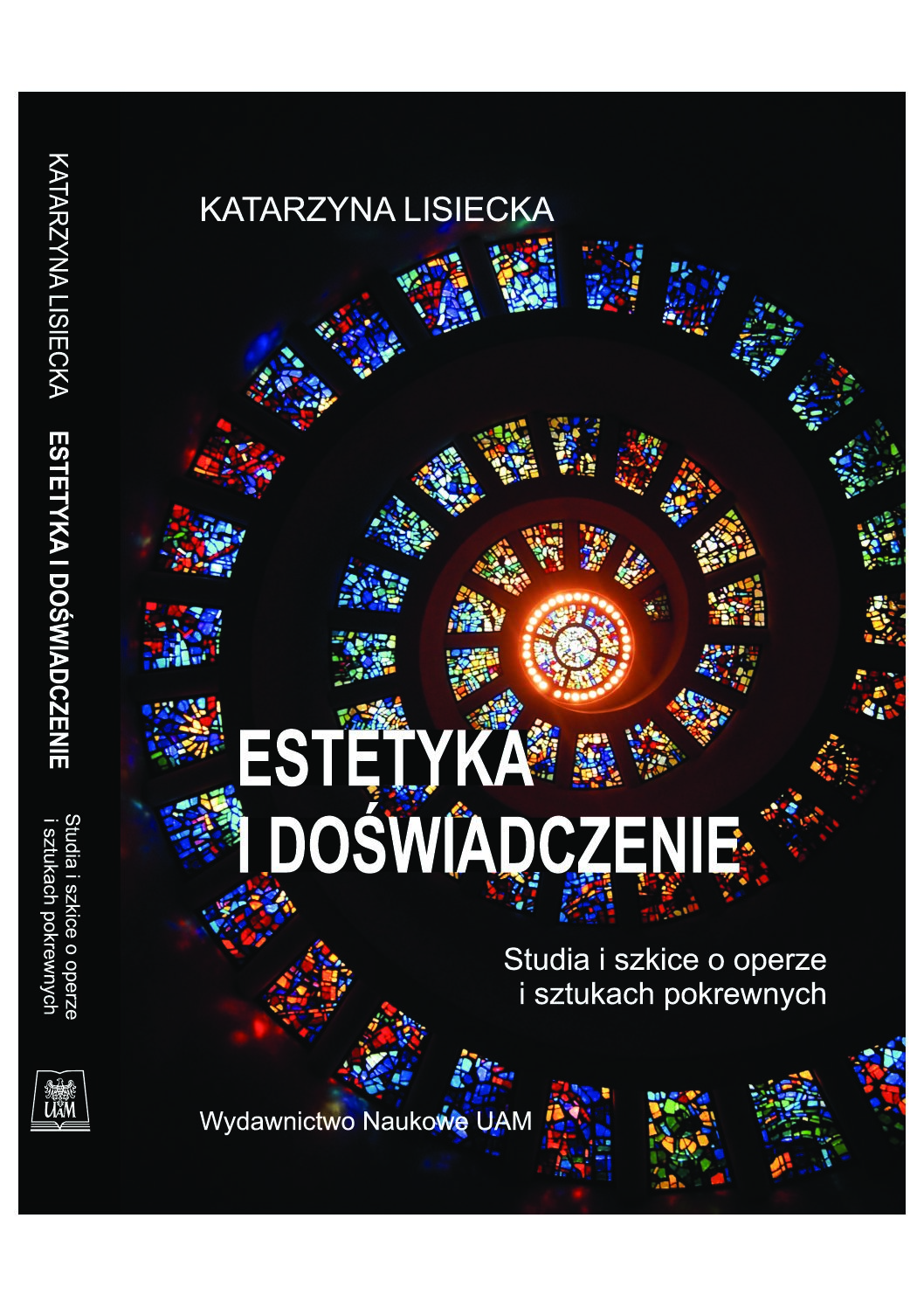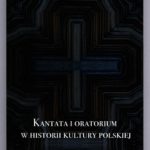13 - 12
2013
„Natchnienie poety i muzyka żenić się z sobą powinny…” Studia i szkice o libretcie, pod red. Elżbiety Nowickiej i Aliny Borkowskiej-Rychlewskiej, Wydawnictwo Poznańskiego Towarzystwa Przyjaciół Nauk, Poznań 2013.
Prezentowana książka stanowi efekt pierwszej fazy zakrojonych na szeroką skalę prowadzonych w Polsce badań nad librettem operowym rozumianym jako integralna część literatury, teatru i kultury muzycznej, traktowanym jako wyjątkowe narzędzie obiegu tematów, idei, wątków, estetyk etc. wspólnych kulturze europejskiej kilku stuleci. Jednocześnie niniejszy tom inicjuje serię książek wyrastających z namysłu nad różnymi aspektami libretta operowego. Szeroki zakres tematów, jaki wyznaczają analizowane w poszczególnych artykułach dzieła i teorie operowe wywodzące się z różnych epok, poza ich samoistną wartością, prowadzi też do wyłonienia kilku głównych obszarów badań rozwijanych w planowanych, przyszłych pracach.
Pośród podejmowanych w tej książce zagadnień Czytelnik znajdzie zatem temat operowych form, rozumianych również jako elementy składowe dzieła operowego, takie jak aria czy recytatyw, problematykę przekładu libretta i adaptacji operowej oraz refleksję nad operą dwudziestowieczną ujętą w perspektywie ówczesnych fascynacji koncepcjami psychologicznymi i antropologicznymi.
Spis treści
Uwagi wstępne
I. W kręgu operowych form
Anna Wypych-Gawrońska, Libretto operowe w poglądach polskich kompozytorów, librecistów i teoretyków XIX wieku
Rüdiger Ritter, „Gdyby Muette zaczęła śpiewać”. Moniuszkowska „Halka” i „Muette de Portici” Aubera
Maciej Straburzyński, „Faust” Antoniego Radziwiłła – w stronę opery literackie
Hanna Winiszewska, Współpraca Carla Goldoniego i Baldassarego Galuppiego a nowy model libretta opery komicznej
Małgorzata Sokalska, Aria – między liryką a epiką
Joanna Maleszyńska, Musical: problemy gatunku
II. Problemy przekładu i adaptacji
Katarzyna Lisiecka, Strategie translatorskie Bogusławskiego w librettach oper włoskich (na przykładzie polskiej adaptacji „L’italiana in Londra” Domenica Cimarosy i Giuseppe Pertoselliniego)
Iwona Puchalska, „Kusy śpiew” i „czułość dosłuchu”, czyli o poezji w libretcie (teorie J.D. Minasowicza z dodaniem uwag o translacjach współczesnych)
Przemysław Krzywoszyński, Powieść Waltera Scotta w blasku libretta. Rzecz o „Łucji z Lammermooru”
Agata Brańka-Banasiak, Przyczynki do twórczości librettologicznej Ingeborg Bachmann
Beata Kornatowska, Ingeborg Bachmann – szkic do portretu librecistki
Aleksandra Bręńska, „No choice for the living, no choice for the dead” – o libretcie opery „Śmierć w Wenecji” Benjamina Brittena
III. Libretto wobec dwudziestowiecznych fascynacji psychologią i erotyką
Tomasz Kowalewski, Operowe gry z płcią. Uwagi o „Tragedii florenckiej” Alexandra Zemlinsky’ego
Marcin Bogucki, Opera i histeria. Inspiracje psychoanalityczne w „Elektrze” Ryszarda Straussa i „Erwartung” Arnolda Schönberga
Piotr Urbański, „The love that passes understanding has come to me”. Uwagi na marginesie „Billy’ego Budda”
Noty o Autorach
Indeks osób
Anna Wypych-Gawrońska, The Opera Libretto in the Opinions of 19 th Century Polish Composers, Libretto Writers and Theoreticians
S u m m a r y
Aesthetic reflection related to the opera libretto as provided in the opinions of 19 th century Polish composers, libretto writers and theoreticians was to a large extent a reflection of a broad discussion accompanying attempts at identifying the mutual relations between literature and music in works where both forms coexisted. It was also an attempt at evaluating the libretto as a separate aesthetic and artistic phenomenon. In their opinions, authors of operas in the 19 th century tried to establish the ideal of the libretto and relations between lyrics and music. The ideal was to be achieved in the form of a perfect balance of arts in an opera. However, in practice there were difficulties with offering works satisfying the authors and the audiences alike.
Rüdiger Ritter, „Gdyby Muette zaczęła śpiewać”. Moniuszko’s Halka and Auber’s Muette de Portici
S u m m a r y
In the research literature on Moniuszko’s opera Halka, the meaning of Polish contexts for the libretto and the opera are stressed. But there are some important connections of the opera with the operatic tradition in Europe which have been neglected in this research. This article points out important parallels of the operas Halka and Muette de Portici by Auber. It is argued that Wolski, with his libretto, and Moniuszko, with his music, both had it in mind to repeat the success of Auber’s revolutionary opera on the Polish stage by adapting the topic to conditions of Polish culture. The parallels between Halka and Muette lead to a better understanding of Wolski’s and Moniuszko’s motivation for Halka. In this article, Moniuszko’s Halka is situated in the framework of French grand opera, of revolu-tionary opera, of the tragedy of the petit bourgeoisie and of Literarian opera.
Maciej Straburzyński, Antoni Radziwiłł’s Faust: towards Literary Opera
S u m m a r y
This text consists of two parts: the first presents a short biography of prince Antoni Henryk Radziwiłł (1775-1833) and a history of performances of his opera Faust (1808-1832), a Singspiel written to illustrate fragments of Goethe’s masterpiece. In part two, Faust is viewed in the context of the literary opera, a late Romantic genre. On the basis of the definition of Literaturoper suggested by Peter Petersen
and Hans-Gerd Winter, the nature of the relations between music and libretto in literary opera are examined (in line with Joseph Kerman’s theory). Formal conditions have also been identified, necessary for the score and libretto to collaborate as a typical feature of this genre. On the basis of the conclusions and a brief structural analysis of Faust, this work has been recognised as a precursor of the literary
opera at the turn of the 19 th and 20 th centuries.
Hanna Winiszewska, Cooperation between Carl Goldoni and Baldassare Galuppi in the Face of a New Model of a Comic Opera Libretto
S u m m a r y
As a librettist, Carlo Goldoni contributed to the development of forms incorporated in the opera and the excellent combination of serious and comic elements in the dramma giocoso. His librettos’ appropriate arrangement of textual structures triggered off specific elements of the comic opera, like the chain finale and introduzione: an ensemble following the overture. The dramma giocoso, a genre which emerged in the course of artistic cooperation between Goldoni and Galuppi, has other characteristics including numerous, grandiose collective scenes and a duet of protagonists predictably preceding the completion of an opera’s third act. For a long time, opera buffa was regarded only as cheap entertainment for the ma-
sses. Seria and buffa operas had formerly been targeted at two different types of audiences. These were integrated through the idea of interweaving comic and serious elements.
Małgorzata Sokalska, The Aria: between Lyric Poetry and Epic Poetry
S u m m a r y
The dynamics of opera librettos are based on the co-existence of two fundamental forms: the recitative (as a factor contributing to the plot’s dynamism) and the aria (a slowing down, halting factor). The numerous Baroque features in an aria can be viewed as autonomous in the dramatic structures of a lyrical entirety with a distinct lyric subject, independent of the opera’s protagonist. The change which affected the aria from the end of the 18 th century and especially during the 19 th century is related to the gradually increasing number of epic elements in this form, e.g. description and short story. Therefore, by signing an aria, an opera protagonist becomes a narrator. This may be related to the reform of opera pushed through by many who had dramatization in mind. In an opera’s libretto, this is achieved by introducing an epic element.
Joanna Maleszyńska, Musical: the Problems of the Genre
S u m m a r y
The article is devoted to the changes in the art of the musical in recent decades: structural, narrative, and above all – thematic. Often approached with a patronizing attitude by Polish scholars as an inferior genre meant for common entertainment, the musical – combining theatre, music, and literature – has become the genre of choice for artists wanting to acquaint a broad public with weighty philosophical, historical, psychological, and existential issues. Many epic works of literature have been adapted for the musical stage (among others, Les Misérables and Notre Dame de Paris), while new productions, such as Korczak or Yodok Story, take on the serious and complex subject matter of the Holocaust and totalitarian
labour camps. The article puts forth a theory that the musical of today is where the sacrum finds its dwelling place.
Katarzyna Lisiecka, Wojciech Bogusławski’s Translation Strategies in Librettos to Italian Operas (on the Example of the Polish Adaptation of L’italiana in Londra by Domenico Cimarosa and Giuseppe Petrosellini)
S u m m a r y
The essay entitled Wojciech Bogusławski’s translation strategies in librettos to Italian operas (on the example of the Polish adaptation of L’italiana in Londra by Domenico Cimarosa and Giuseppe Petrosellini) is an attempt at identifying issues related to the activity of the father of the Polish theatre as an adaptor and translator of opera librettos. L’italiana in Londra deserves a separate discussion, as it provides numerous examples of Bogusławski’s translation strategies, which are key to his method of translating dramatic and music works. Bogusławski, the father of Polish theatre, focused primarily on capturing and maintaining the dramatic and actorly potential of the opera which oftentimes involved limitations on its musical parameters. While this type of reduction of musical elements consisted chiefly
in introducing spoken dialogues to replace recitatives, it did not affect L’italiana in Londra’s overall dramatic structure. On the contrary, Bogusławski managed to emphasize and magnify its comedic values. This translation strategy contributed to the opera’s increased stage attractiveness and addressed that part of the audience not sufficiently familiar with opera conventions.
Iwona Puchalska, „Kusy śpiew” and „czułość dosłuchu”: about Poetry in the Libretto (Theories by J.D. Minasowicz with Comments on Contemporary Translations)
S u m m a r y
The article’s starting point is the concept of libretto translation developed by Józef Dionizy Minasowicz, published as Kilka rad dla piszących poezje do śpiewania, a w szczególności dla tłomaczów textów operowych [Some advice for those who write poetry to be sung, in particular for translators of opera texts]. This dissertation is two-dimensional (theoretical and practical) and combines general translational
reflection with numerous technical guidelines. It serves as a starting point for an analysis of the specificity of translating poetry to be sung, its impact on purely literary translations and its roots in libretto-related theories in specific epochs. The notion of libretto translation has been extended ( in a performative approach) to contemporary conditionings, traditions and modes of translating and presenting an opera text to the audience.
Przemysław Krzywoszyński, Walter Scott’s Novel in the Splendour of the Libretto. Notes on The Bride of Lammermoor
S u m m a r y
The goal of this article is to compare Walter Scott’s novel The Bride of Lammermoor with the libretto Lucia di Lammermoor by Salvatore Cammarano to music written by Gaetano Donizetti. The significant discrepancies between the libretto and the novel, including editorial cuts, the unspecified historical time and reduction of the number of protagonists, did not negatively affect the plot’s dramatic nature. The
historical novel by the Scottish writer, many times adapted for the stage, enjoyed even greater fame owing to Donizetti’s opera. To a large extent, the composer’s success should be attributed to its subject, so popular in Romanticism, but also to the excellent dramatic rendition by the librettist. Both the novel and the opera became sources of inspiration for subsequent generations of artists: writers, painters and
composers alike. From a contemporary perspective it looks like Donizetti’s opera outshone the novel, even though the latter has never slipped into oblivion.
Agata Brańka-Banasiak, Contributions to Ingeborg Bachmann’s Libretto Writing
S u m m a r y
The text is an attempt at presenting to Polish readers the status of research into German-language librettos and the identification of Ingeborg Bachmann’s early work. At the same time it is an indication of the important role of grappling with the form of the libretto in the poet’s creative development.
Beata Kornatowska, Ingeborg Bachmann: a Sketch to a Portrait of a Librettist
S u m m a r y
Ingeborg Bachmann (1926–1973), an Austrian poet and prose-writer, authored librettos to works by Hans Werner Henze (1926–2012), one of the most distinguished contemporary German composers. The article presents the most important stages of cooperation between the creators, Bachmann’s opinions on the relationship between lyrics and music expressed in the essay, Musik und Dichtung, excerpts from a methodological reflexion on the librettist’s work, as well as her only completed original libretto written by Bachmann, to The Young Lord opera (1965) based on a fairy tale, The Ape as Man (1826) by Wilhelm Hauff. A description of the plot (the opera remains unknown in Poland) is followed by an analysis of structural and linguistic tools, testimony to the librettist’s sophisticated writing techniques, used in a critique of the language and the society.
Aleksandra Bręńska, „No choice for the living, no choice for the dead”: about the Libretto for the Opera Death in Venice by Benjamin Britten
S u m m a r y
The goal of this article is to examine the relations between the text of Death in Venice by Thomas Mann and the opera’s libretto as well as establishing the attitude adopted by Benjamin Britten and Myfanwy Piper toward the interpretation. Use of the intermedia translation method was key in demonstrating that the authors’ intention was to focus on the symbolic reception of the text and the polarization of meanings. The internally torn Aschenbach is juxtaposed with his antagonist, who assumes seven subsequent roles in the drama. As a result, the acts of a mysterious figure were given a demonic dimension which led to the major protagonist’s destruction. The libretto’s coherence and the score’s hermetic motifs are evidence of the close cooperation between Britten and Piper.
Tomasz Kowalewski, Representations of Gender and Sexuality in Opera: Remarks on Alexander Zemlinsky’s A Florentine Tragedy
S u m m a r y
A Florentine Tragedy of is an opera in one act by Alexander Zemlinsky to a libretto adapted by the composer after a fragment of an uncompleted play by Oscar Wilde of the same title. The work features an erotic triangle – a woman (Bianca), her husband (Simone) and her lover. Simone, a Florentine merchant finds his wife in the arms of a young prince, Guido Bardi. Simone challenges the seducer to a fight with swords, disarms, and strangles him. The article explores the homosocial and homoerotic context of Wilde/Zemlinsky’s drama. This new reading of the opera is a contribution to the discussion on rediscovery of long-forgotten operas and revision of the operatic canon.
Marcin Bogucki, Opera and Hysteria. Psychoanalytical Inspirations in Ryszard Strauss’s Electra and Arnold Schönberg’s Erwartung
S u m m a r y
The goal of this article is to follow the inspiration of Sigmund Freud’s and Josef Breuer’s Studien über Hysterie and to ponder the resulting literary aspects of the librettos in two works from the early 20 th century, namely Elektra by Richard Strauss, with Hugo von Hofmannsthal’s libretto (1906-1908, premiered in 1909), and the monodrama Erwartung (Anticipation) (1909, premiered in 1924) by Arnold
Schönberg with Marie Pappenheim’s libretto. The context for the considerations is provided by a discussion on the nature of hysteria across the centuries, the emergence of psychoanalysis in the late 19 th and early 20 th centuries and its impact on the fin de siècle.
Piotr Urbański, „The love that passes understanding has come to me”: Remarks on Staging Billy Budd
S u m m a r y
The aim of the present paper is to analyse the interrelation between Herman Melville’s short story, the opera libretto as well as its staging, represented here by two stage productions of Billy Budd released on DVD, making a summary of the proposed interpretative traditions. The first of them is a studio production of the BBC, recorded in September 1966 and staged for the first time on the 11 th of
December 1966. It was directed by Basil Coleman who prepared the premieres for both versions (DVD release date: 2008). The other production was recorded in 1988, directed by Tim Albery (DVD release date: 2004).Both stage productions under debate testify to certain ways in which the 20 th century opera theatre dealt with homoerotism implied in the work. It needs to be mentioned that the stage production of Billy Budd as well as its studio production by Coleman emerged in the period when homosexual acts were penalized by the British law, which resulted in understatements, about which Forster complains in Alan Hollighurst’s novel The Swimming Pool Library. Melville’s characters seemed
to constitute an excellent excuse for the replacement or suppression of sexual relations by the introduction of the issues of domination and submission, underscored chiefly by the second production. E.M. Forster adopted a writing technique in Billy Budd akin to that his readers will remember from Maurice, namely the strategy of understatement, silence, nicknaming; to put it metaphorically: the re-
solution to leave “sensitive” textual spots untranslated from Greek into English.







